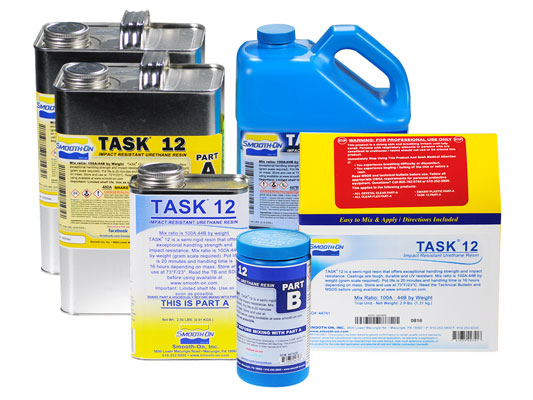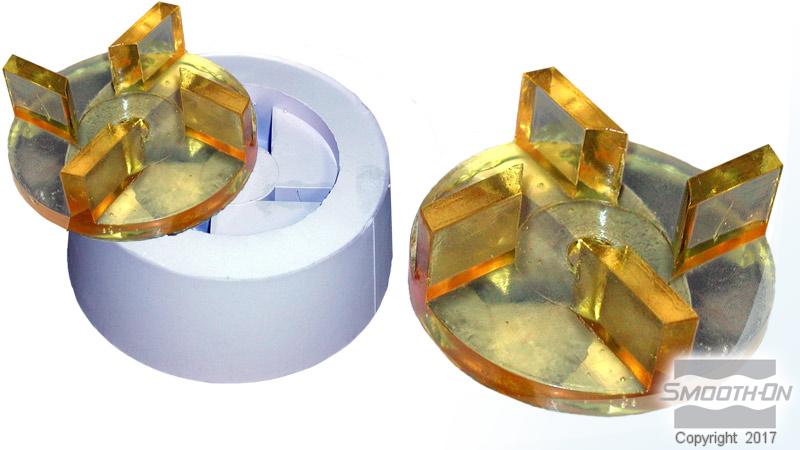TASK™ 12

浇注件坚固、耐用。TASK™12可以着色或填充,用于各种工业应用,包括制造原型模型、高冲击部件和工具。
小心:不适用于家庭使用。此产品仅供工业使用。需要适当的通风,佩戴NIOSH认可的呼吸器和防护服以减少吸入和皮肤过敏的风险。如果呼吸受到影响或出现皮疹,请立即停止使用本产品并寻求医疗救助。使用前阅读MSDS。
说明
Because no two applications are quite the same, a small test application to determine suitability is recommended if performance of this material is in question.
Applying A Release Agent - A release agent is necessary to facilitate demolding when casting into or over most surfaces. Use a release agent made specifically for mold making (Universal™ Mold Release or Mann’s Ease Release™ 200 available from Smooth-On or your Smooth-On distributor). A liberal coat of release agent should be applied onto all surfaces that will contact the plastic.
IMPORTANT: To ensure thorough coverage, apply release and brush with a soft brush over all surfaces. Follow with a light mist coating and let the release agent dry for 30 minutes.
Smooth-On silicone rubber molds usually do not require a release agent unless casting silicone into the mold. Applying a release agent will prolong the life of the mold.
Measuring - The proper mixing ratio is 100 Parts of Part A to 44 Parts of Part B by weight. You must use an accurate scale (gram scale or triple beam balance scale) to weigh the Part A and Part B components properly. Dispense the required amount of Part A into a mixing container. Weigh out the appropriate amount of Part B and combine with Part A.
Mixing - Part B (blue label) must be stirred well before use to redisperse ingredients that have settled. Mix thoroughly for 90 seconds. Stir slowly and deliberately making sure that you scrape the sides and bottom of the mixing container several times.
IMPORTANT: Shelf life of product is reduced after opening. Remaining product should be used as soon as possible. Immediately replacing the lids on both containers after dispensing product will help prolong the shelf life of the unused product. XTEND-IT™ Dry Gas Blanket (available from Smooth-On) will significantly prolong the shelf life of unused liquid urethane products.
Vacuuming - TASK™ products are low in viscosity and do not require vacuum degassing. If you choose to vacuum the material, subject mixture to 29 h.i.g. mercury in a vacuum chamber until mixture rises, breaks and falls. Allow for 3 to 4 times volume expansion in mixing container. Be aware of pot life so that material does not set up in mixing container.
Pouring - Pour mixture in a single spot at the lowest point of the mold. Let the mixture seek its level. A uniform flow will help minimize entrapped air.
For Best Results . . . Best results are obtained using a pressure casting technique. After pouring the mixed compound, the entire casting assembly (mold, dam structure, etc.) is placed in a pressure chamber and subjected to 60 PSI (4.2 kg/cm2) air pressure for the full cure time of the material.
Curing - Important: Use this product with at least room size ventilation or in proximity to a forced outlet air vent and do not inhale/breath fumes. Fumes, which may be visible with a significant mass concentration, will quickly dissipate with adequate ventilation. Castings with significant mass may be hot to the touch and irritate skin immediately following cure. Let casting cool to room temperature before handling.
Demold time of the finished casting depends on mass and mold configuration. Low mass or thin-walled castings will take longer to cure than castings with higher mass concentration.
If making rotational or hollow castings, backfilling with a rigid foam (Foam-iT! 5 or other) will provide lightweight reinforcement. Foam backfilling is recommended if castings will be subjected to temperatures above 85°F / 30°C.
Post Curing - Castings will reach “full cure” faster and achieve maximum physical properties and heat resistance if TASK™ 12 is post cured. Castings should be post cured in a mold or support structure. Allow the material to cure for 16 hours at room temperature followed by 4 - 8 hours at 150 - 160°F (65 - 72°C). The casting or part should be allowed to cool to room temperature before handling.
Performance - Cured castings are rigid and durable. They resist moisture, moderate heat, solvents, dilute acids and can be machined, primed/ painted or bonded to other surfaces (any release agent must be removed). If machining cured TASK™ plastics, wear dust mask or other apparatus to prevent inhalation of residual particles. Castings can be displayed outdoors after priming and painting.
